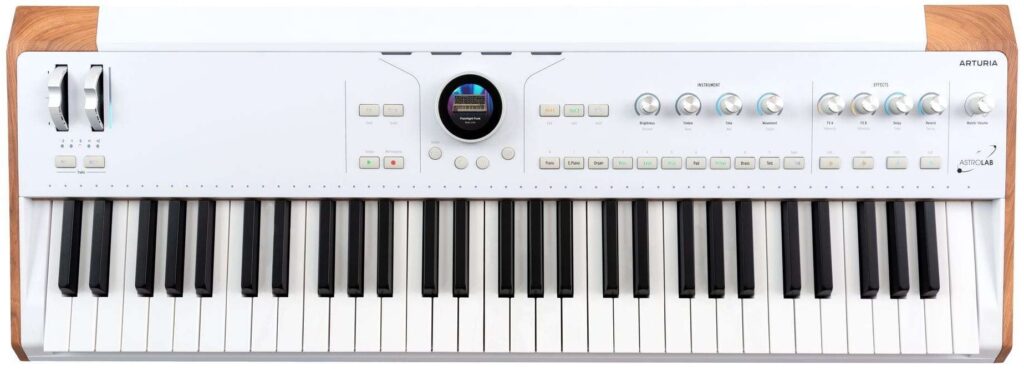Arturia have announced its new Arturia AstroLab featuring many (most?) of their AnalogLab instruments and presets: 34 instruments, 1,300 presets. You’ll find lots of pre-release demos on the Interwebs. I recommend the Arturia playthrough video which doesn’t have any yakking.
I’m excited by the AstroLab if, for no other reason, it’s the first significant alternative to the all-in-ones offered by the kaiju (Yamaha, Roland, Korg, Nord, etc.) The current sound set is very comprehensive even though a few Analog Lab instruments for AstroLab are still in development.
A few quick observations. The AstroLab is bi-timbral. That means splitting two independent voices or layering two voices. That might seem limiting, but I rarely use humungous stacks when playing live. The knobs (endless encoders) light up with the color matching the assigned layer or split voice. Neat. Piano and organ polyphony is 48; poly synth polyphony is 8.
There are four endless encoders to control voice parameters and four encoders to control the effects: effect A, effect B, delay and reverb. No sliders. The lack of sliders may raise eyebrows, but you can add a secondary MIDI controller through a USB-A port.
Speaking of encoders, you probably noticed that dial-like thingy in the middle of the front panel. Arturia have invented an innovative control which merges a big wheel with a high-resolution color display in the middle. The wheel turns left and right, and responds to clicks and pressure from the top. One may need to be a little careful so as to avoid inadvertent clicks while turning the wheel.
The keyboard is described as semi-weighted piano keys, channel aftertouch. Natch, one really needs to get the keys under the fingers to discover if the key-feel is really for you. In such a premium-level keyboard, I doubt if Arturia built in a cheapo keybed.
Internal storage is 22GBytes and only 7GBytes are used. That leaves plenty of room for expansion including the new instruments coming to AstroLab at some future date.
Sound editing is generally limited to what is assigned to the encoders. For deep sound editing, you’ll need a licensed copy of the relevant AnalogLab instrument (bundled or individually). In other words, separate software licenses are needed in order to deep-edit.
Physically, AstroLab is an attractive package weighing 22 pounds. That’s a little hefty for me, but is well within reason for a full 61-key instrument. The chassis is metal with molded end-cheeks. (That ain’t natural wood you’re seeing.) The goes-ins and goes-outs are well-provided for including 1/4 inch pedal jacks and 5-pin MIDI.
I see AstroLab priced at $1,600 USD (MAP or “street”) putting it up against Yamaha MODX, Korg Nautilus, Roland JUNO-X and Fantom-0, just to mention a few other products in this pricing tier.
I — for one — would like to try AstroLab and get a feel for the keybed. I’m also curious to hear and control the Hammond B-3 emulation. Would be nice to have sliders for drawbar control, but there is a nice, big flat area on the AstroLab front panel for my Crumar D9U.
A full demo on the new Arturia AstroLab with Bert Smorenburg — good to see and hear Bert!
Copyright © 2024 Paul J. Drongowski

